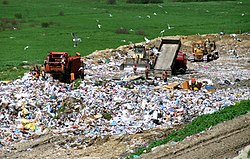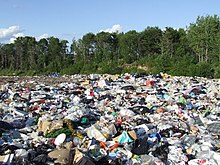Landfill

A landfill site (also known as a tip, dump, rubbish dump or dumping ground and historically as a midden[1]) is a site for the disposal of waste materials by burial.
A landfill also may refer to ground that has been filled in with rocks instead of waste materials, so that it can be used for a specific purpose, such as for building houses. Unless they are stabilized, these areas may experience severe shaking or liquefaction of the ground during a large earthquake.
Operations

Typically, in non-hazardous waste landfills, in order to meet predefined specifications, techniques are applied by which the wastes are:
- Confined to as small an area as possible.
- Compacted to reduce their volume.
- Covered (usually daily) with layers of soil.
During landfill operations the waste collection vehicles are weighed at a weighbridge on arrival and their load is inspected for wastes that do not accord with the landfill’s waste acceptance criteria. Afterward, the waste collection vehicles use the existing road network on their way to the tipping face or working front where they unload their contents. After loads are deposited, compactors or bulldozers are used to spread and compact the waste on the working face. Before leaving the landfill boundaries, the waste collection vehicles pass through a wheel cleaning facility. If necessary, they return to the weighbridge in order to be weighed without their load. Through the weighing process, the daily incoming waste tonnage can be calculated and listed in databases for record keeping. In addition to trucks, some landfills may be equipped to handle railroad containers. The use of 'rail-haul' permits landfills to be located at more remote sites, without the problems associated with many truck trips.
Typically, in the working face, the compacted waste is covered with soil or alternative materials daily. Alternative waste-cover materials are chipped wood or other "green waste",[2] several sprayed-on foam products, chemically 'fixed' bio-solids and temporary blankets. Blankets can be lifted into place at night then removed the following day prior to waste placement. The space that is occupied daily by the compacted waste and the cover material is called a daily cell. Waste compaction is critical to extending the life of the landfill. Factors such as waste compressibility, waste layer thickness and the number of passes of the compactor over the waste affect the waste densities.
Social and Environmental Impact

Landfills may cause a number of problems. Damage can include infrastructure disruption, such as damage to access roads by heavy vehicles. Pollution of the local environment may occur as well, such as contamination of groundwater or aquifers by leakage or sinkholes[3] or soil contamination. Pollution of local roads and water courses from wheels on vehicles when they leave the landfill can be significant and can be mitigated by wheel washing systems.
Methane generated by decaying organic wastes may be released into the atmosphere. Methane is a greenhouse gas many times more potent than carbon dioxide, and can itself be a danger to inhabitants of an area because it is flammable and potentially explosive. Landfills may become a reservoir of disease organisms and disease vectors such as rats and flies, particularly from improperly operated landfills, which are more common in developing countries. Other issues include injuries to wildlife and nuisance problems such as dust, odor, vermin, noise pollution and reduced local property values.
Though offsite impacts of landfills are of primary concern to regulators, the status of the resident microbial community in a landfill may determine the efficiency with which natural attenuation of contaminants proceeds on site. For example, Gomez et al. (2011) showed that bacterial diversity, including diversity of pollutant degraders was variable within a major landfill site in Medellin, Colombia and was related to the level of contamination within a particular zone.[4]
Landfill gas
Gases are produced in landfills due to the anaerobic digestion by microbes on any organic matter. This gas can be collected and flared off or used to generate electricity in a gas fired power plant. Landfill gas monitoring can be carried out to alert for the presence of a build-up of gasses to a harmful level.
Regional practice
The examples and perspective in this section may not represent a worldwide view of the subject. (December 2010) |


Canada
Landfills in Canada are regulated by provincial environmental agencies and environmental protection acts (EPA).[5] Older dumps tend to fall under current standards and are monitored for leaching.[6] Some former dumps have been converted to parkland and close to residential developments.
Historically, Canadians used the euphemism "nuisance grounds" to refer to a landfill site.[7] This was still used in 2012, in, for example, the Rural Municipality of Montcalm.[8]
European Union
In the European Union, individual states are obliged to enact legislation to comply with the requirements and obligations of the European Landfill Directive. In the UK this is the Waste Implementation Programme.
United Kingdom
Landfilling practices in the UK have had to change in recent years to meet the challenges of the European Landfill Directive. The UK now imposes landfill tax upon biodegradable waste which is put into landfills. In addition to this the Landfill Allowance Trading Scheme has been established for local authorities to trade landfill quotas in England. A different system operates in Wales where authorities are not able to 'trade' between themselves, but have allowances known as the Landfill Allowance Scheme.
United States
In the U.S., landfills are regulated by each state's environmental agency that establishes minimum guidelines; however, none of these standards may fall below those set by the United States Environmental Protection Agency (EPA).
Microbial degradation
Bacteria that digest plastic have been found in landfills. [9]
Reclaiming materials
Landfills can be regarded as a viable and abundant source of materials and energy. In the developing world, this is widely understood and one may thus often find waste pickers scavenging for still usable materials. In a commercial context, landfills sites have also been discovered by companies, and many have begun harvesting materials and energy .[10] Well known examples are gas recovery facilities.[11] Other commercial facilities include waste incinerators which have built-in material recovery. This material recovery is possible through the use of filters (electro filter, active carbon and potassium filter, quench, HCL-washer, SO2-washer, bottom ash-grating, etc.). An example of these is the AEB Waste Fired Power Plant.[12][13] The AEB waste incinerator is hereby able to recover a large part of the burned waste in source materials. According to Marcel van Berlo (who helped build the plant), the processed waste contained higher percentages of source materials than any mine in the world. He also added that when the plant was compared to a Chilean copper mine, the waste fired plant could recover more copper.[14] However, because of the high concentration of gases and the unpredictability of the landfill contents, which often include sharp objects, landfill excavation is generally considered dangerous. Furthermore, the quality of materials residing within landfills tends to degrade and such materials are thought to be not worth the risks required to recover them.
Alternatives
The alternatives to landfills are waste reduction and recycling strategies. Secondary to not creating waste, there are various alternatives to landfills. In the late 20th century, alternative methods of waste disposal to landfill and incineration have begun to gain acceptance. Waste-to-energy incineration, anaerobic digestion, composting, mechanical biological treatment, pyrolysis and plasma arc gasification have all begun to establish themselves in the market.
In recent years, some countries, such as Germany, Austria, Sweden, Denmark, Belgium, the Netherlands, and Switzerland, have banned the disposal of untreated waste in landfills. In these countries, only the ashes from incineration or the stabilized output of mechanical biological treatment plants may still be deposited.
See also
- Bioreactor landfill
- Daily cover
- Decompiculture
- Fly-tipping
- Hydrologic Evaluation of Landfill Performance or HELP modfu
- Land reclamation
- Landfill diversion
- Landfill tax
- List of solid waste treatment technologies
- Marine debris
- Mechanical biological treatment
- Milorganite
- NIMBY
- Open dump
- Sludge
- Solid Waste Association of North America
- Waste management
References
- ^ "Midden". Merriam-Webster. Retrieved 18 May 2014.
- ^ "Alternative Daily Cover (ADC)". Retrieved September 14, 2012.
- ^ "Five years on, east Pasco landfill proposal still in dispute". Tampa Tribune. July 8, 2011. Retrieved 2011-07-13.
- ^ Gomez, A.M.; =Yannarell, A.C.; Sims, G.K.; Cadavid-Resterpoa, G.; Herrera, C.X.M. (2011). "Characterization of bacterial diversity at different depths in the Moravia Hill Landfill site at Medellín, Colombia". Soil Biology and Biochemistry. 43 (6): 1275–1284. doi:10.1016/j.soilbio.2011.02.018.
{{cite journal}}: CS1 maint: extra punctuation (link) - ^ Landfill Inventory Management Ontario - How Ontario regulates Landfills - Ministry of the Environment
- ^ Aging Landfills: Ontario’s Forgotten Polluters - Eco Issues
- ^ Nuisance Grounds & Other Garbage Words at Bill Casselman's Canadian Word of the Day & Words of the World at www.billcasselman.com
- ^ Nuisance Grounds | RM of Montcalm
- ^ Gwyneth Dickey Zaikab (March 2011). "Marine microbes digest plastic".
- ^ Multiple Purpose industries using landfills for energy
- ^ Commercial exploitation of gas from landfills
- ^ AEB Waste Fired Power Plant
- ^ Waste fired power plant by AEB recovers materials
- ^ Kijk magazine, April 2008
Further reading
- "Council Directive 1999/31/EC of 26 April 1999, on the landfill of waste" (PDF). Retrieved August 29, 2005.
- "The Landfill Operation Management Advisor Web Based Expert System". Retrieved August 29, 2005.
- H. Lanier Hickman Jr. and Richard W. Eldredge. "Part 3: The Sanitary Landfill". A Brief History of Solid Waste Management in the US During the Last 50 Years. Retrieved August 29, 2005.

